Oral Arguments on “Massive Disclosures” from cases 003 and 004 at the Trial Chamber for Case 002/02
Today, on August 10th, the Court reconvened to continue hearing witnesses on the Trapeang Thma Dam (TT Dam) worksite.
For a short summary of the crimes which are alleged to have been committed by the defendants at this worksite—crimes against humanity including enslavement, executions and forced marriages—read the beginning of the July 27th post here.
Before the witness took the stand, the Bench heard oral submissions on the “forwarding” of 200 civil party applications from case 003 and 004 that will be available this week and which may materially affect the choice of civil parties as related to the Trapeang Thma Dam.
—
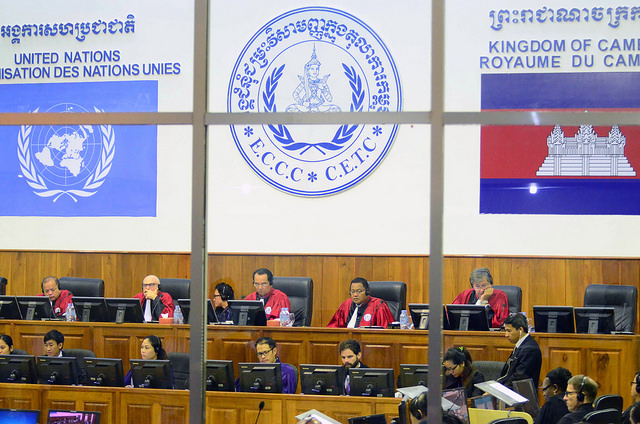
The Bench of the Trial Chamber on Aug. 10 2015. Judge Sokhan presiding. Mr. Koppe and Ms. Guissé, lawyers for the accused Nuon Chea and Khieu Samphan, respectively, can be seen on the bottom right corner. (ECCC Flickr)
Judge YA Sokhan (presiding since Judge Nonn is off) made three points before giving the floor to the parties for 10-minute-long oral arguments:
- 1) First, Judge Sokhan asked the parties to distinguish between the relevance of admissions in civil party applications in cases 003 and 004 generally, as opposed to Civil Parties that are parties in both cases 002/2 and 003 or 004.
- 2) This is because, Judge Sokhan said, parties that are not parties in case 002 cannot appear before this Chamber.
- 3) Lastly he recalled that witness and civil parties may be recalled due to facts disclosed in cases 003 and 004.
Civil Parties asks for two-weeks extension
Marie Guiraud, Civil-Party Lead Lawyer, explained how these oral submissions on new disclosures came about. She says that the notification of the new 200 civil party applications from cases 003 and 004 to be disclosed was given last Thursday August 6, 2015.
“This massive forwarding of applications will materially affect the civil party applications that we choose for this part of the case 002/02,” Ms. Guiraud explained, “we have to check that there are no documents that are relevant to civil parties in case 002/02.”
She explained that these disclosures had a direct impact on the list of civil parties that they had prepared. The most urgent of the issues that was raised because of this disclosure was that the filing deadline for the list of civil parties was just one day after these new disclosures. As such, the Civil Party lawyers submitted the list by the 3 p.m. deadline on Friday August 7th. Nevertheless, Ms. Guiraud asked that they be given the chance to amend the list after reviewing the 200 civil party applications. She said she needed two weeks to become acquainted with these documents because they may materially affect the civil parties application list.
Ms. Guiraud then argues that one of the consequence may be that the impact hearing on the Trapeang Thma Dam (TT Dam) must be postponed. She asks the Bench to either postpone the impact hearings on the three worksites (1st Jan. dam, Kampong Chhnang Airport, and TT Dam) or to just postpone the hearing on the TT Dam.
The last request from Ms. Guiraud is that they would like to be informed with regards to the way that the co-prosecutors will proceed with forthcoming disclosures. She asks two questions to the prosecution:
- 1) Does the prosecutor intend to forward other civil party application from 003 and 004?
2) How often will information on these releases be given so that we can prepare in advance?
Mr. Mr. VEN Pov, Civil Party Co-Lawyer, explains that there are civil parties in case 003/004 that are also civil parties in case 002 and they need to review these files.
—
Mr. William Smith, Deputy Co-Prosecutor, then takes the floor.
The prosecution does not object to amending the list of civil parties by the civil party lawyers but asks that if there is a change in the list, that the prosecution and all parties be notified a few days before the civil parties come to the court to testify.
Mr. Smith reiterates that only if civil parties are parties to both case 002 and 003 or 004 are they relevant. He also clarifies that reviewing those files would not take that long.
Keep the schedule
He asks he Bench to keep the schedule for the document and impact hearings for the three worksites (1st January Dam, KC Airport, and TT Dam) but does not object to postponing the document hearing for civil parties as related to the TT Dam.
The prosecution would have preferred, Smith explains, that the document and impact hearings follow at the end of each segment of the court; i.e., right after the last witnesses and civil parties on the 1st Jan. Dam. for example. The main reason behind this preference, he says is so the parties and the public can deal with each factual scenario in due time. This would assist in keeping the totality of the segment in mind. Thus, Smith says, “we would certainly ask that the schedule wouldn’t be changed for the 1st January Dam and the KC Airport hearings.”
The obligation to disclose
Smith recalls that on Monday, July 27th Dale Lysak, Senior Prosecutor, talked about the obligation to disclose exculpatory evidence and reiterates that disclosures are a top priority for the prosecution. He explains that there are thousands and thousands of pages and that is why it is difficult and frustrating but assures everyone that the prosecution is committed to making sure all parties have the opportunity to review these pages.
“Unfortunately,” Smith says, “that is the nature of crimes against humanity: they are massive violations across a large population across a full country.”
Smith underscores that disclosures are an essential part of a fair trial and they were a central case in other tribunals.
Mr. Smith then went on to say that the prosecution concurs with the approach of the Bench, which was that if new material brings up useful evidence for the defense or the prosecution or civil parties, then the bench would call those witness. The prosecution also concurs with the Bench’s approach to recalling witnesses if the need arises because of new disclosures.
Investigation in cases 003 and 004 to last until end of 2016?
Mr. Smith explains that the two concurrent investigation in cases 003 and 004 are ongoing and will continue and conclude in 2016. He explains that some of that evidence overlaps with this trial. “It is a absolutely certain that a percentage of that investigation will be relevant to this trial,” he said.
The reasoning behind these massive disclosures, Smith says, is that at no point during or at the end of this trial, does the prosecution want to be in a position whereby the defense accuses the prosecution of having buried or hidden evidence.
“The fact is that this frustration [with the large amount of material being disclosed] is part of the prosecution of international crimes and that is what all of us in the court room have been trained to do,“ he exclaims.
Smith then gives concrete information on the disclosures. He explains that the ones relating to the TT Dam will be filed this afternoon and should be available to all parties by Wednesday.
New policy for disclosures
He then explains that the new policy regarding disclosure of Civil Party Applications, which unfortunately does not apply to these disclosures at hand (he would later add that it would also apply to Written Record of Interviews (WRIs) of witnesses) is that the prosecution would indicate which would be more likely to be entered as evidence under rule 87(4) and which would be less likely. He says this is being done to reduce the burden on the defense.
Evidence of the credibility of the evidence
Smith finishes by reiterating that the first priority of the prosecution was the WRIs and explains that the prosecution is erring on the side of safety in disclosing more than is necessary because the prosecution is under a legal duty to disclose all evidence regardless of whether it is inculpatory, exculpatory, or evidence that affects the credibility of the evidence.
“What affects the credibility of the evidence is very complex,” Smith says “if one witness says she worked for 13 hours each day and another says she worked for 14 hours, does that affect the credibility? As a result the prosecution has erred on the side of disclosing more than necessary.”
____
Judge Lavergne asks two questions:
- 1) He asks the prosecution if parts of the civil party applications will be filed or all of it and how many? He says this is because the prosecution has two obligations: to disclose all relevant information but can also file only part of it.
- 2) The second question to civil party lawyers is affirming that the two weeks requested by them to extend the deadline for amending the civil party list would make the new deadline August 24. Since the victim impact statement hearings are scheduled for September 2nd and 3rd, that would be more than enough time to review the list by all parties and give adequate notification if amended.
Marie Guiraud, civil party lead co-lawyer, responds that the parties, or at least her, had not heard about the scheduled hearings on 2 and 3rd of September but yes, that that would suit her well if that was the case.
Mr. Smith then responds to Lavergne and clarifies the new policy on disclosures that was detailed above. He adds though that the policy is a reaction to what was said by the defense on Monday July 27, 2015. He says he understood their submission on that day that unless the civil party application were being put forward as evidence under rule 87(4) they should not be disclosed. “Enough is enough,” Smith said he had understood the defense position to be.
As explained above the new policy would be to classify each disclosure as likely or less likely to be submitted as new evidence under rule 87(4)[footnote 1 for the full text of the rule]. This would be to diminish the burden on the defense, he repeats.
Smith adds that the prosecution has no objection to the defense teams asking for more time to review documents, even if it is more than the rule of only allowing 10 to 15 days. He says that in most cases this would be a reasonable request.
—
The floor is then given to the defense for Nuon Chea, as represented by Mr. Victor Koppe.
Koppe says he has been listening but does not follow “to the maximum.”
He reminds the Chamber that two weeks ago the court had this same discussion with 50 civil party applications and the hearings were postponed for a week. Then a new discussion as related to the disclosure of DC-Cam statements also occurred.
“Now there are 200 civil party applications [to be disclosed],” Koppe says “and not all of it will be submitted as evidence but we still have to read it.”
Koppe then says tells the Bench that “ in your earlier decision, you said that witness may be recalled, but that in practice this may not work as sometimes it is only a small statement that needs to be put forth before a witness.”
He adds that he does not see the difference with the discussion form last week apart from the fact that some of these disclosures are not going to be submitted as evidence.
The question, he says, is whether we should continue hearing witness on the TT Dam or wait until case and 003 and 004 are finished.
“Should we continue with this very difficult situation of a continuous stream of new evidence?” Koppe asks. “Why not simply freeze this segment and continue with it when the investigation of cases 003 and 04 is over?” he continues.
—-
Anta Guissé, lawyer for Khieu Samphan, is then given the floor.
She says that the discussion here goes beyond the procedural issues raised in the past.
She says she does not object of Guiraud’s request to ask for more time to review documents, as she “understands their struggle.”
She explains that “we cannot be riding several horses at the same time” in reference to preparing witness and reading new evidence at the same time.
She says that there may be a change in the prosecutions position but does not say whether she welcomes it or is indifferent or against it. “This is easy for the prosecution to say,” she adds, “because they are aware of the documents, but the defense and civil parties have another position because they are not aware of them.”
She restates the fact that the work necessary to incorporate documents into the defense strategy requires more work than just reading them. She does not say it this time around but she is perhaps sayings that she does not want other people making decisions of which documents are relevant and which ones are not.
“I have not seen the 200 documents,” she exclaims, “so I cannot say what impact they would have, [but] resources are limited and the days are only 24 hours long.”
She ends by saying that we should have a real discussion about the way these documents are disclosed, without explaining what she means. She then says that “we will try to be flexible but of course not at the expense of the defense of our client.”
—
Mr. Smith then takes the floor to respond to both defense teams:
He says that the problem of freezing the TT dam segment would be that the consequence is that this whole case is postponed for one whole year.
Smith argues that the Office of the Co-Prosecutors (OCP) has found a solution as proposed earlier that creates an expeditious and fair trial. Smith does concede that Koppe’s solution of freezing the TT Dam segment is ideal but not workable.
One thing is clear, Smith says, that is that the prosecution has an obligation to disclose and he repeats that these disclosures are going to keep happening
He proposes to expedite the disclosure mechanism, in regards to obtaining authorization from OCIJ quicker, although he says they have gotten much better. Smith also mentions that maybe the the defense could be involved in the disclosure mechanism but does not specify how. Later he just asks if they want to receive the disclosures every week or every two weeks.
Smith says that after these 200 documents are disclosed the backlog is solved and afterwards there would be 2 a week. He believes it is now “an efficient system.”
He wants to be very clear about how and why they are doing what they are doing “so that what we do would not be criticized but understood.”
Smith finishes his response by bringing up the figure of 4,000 civil party application that have been submitted and compares that number to how many have actually been put forward, but does not tell us what that number is in total.
___
Judge Lavergne has more questions for the OCP, represented here by Mr. Smith.
Judge Lavergne starts by commenting that the TT Dam segment is particularly sensitive to evidence coming from cases 003 and 04. It may also have an impact, he says, on other segments such as the segments on the Cham, the Vietnamese, Former Lon Soldiers and “even S-21” so Judge Lavergne and asks for a long vision.
Smith responds that that should be done in writing but he can give some numbers now.
He says that on Wednesday the defense will receive around 30 civil applications on the Cham. From that point forward, Smith says, that in 2 week time, there will be new disclosures from cases 004 and 003 and details exact numbers from cases 04 and 03.
He says that less than 221 civil party applications from case 003 will or have been disclosed in total and 650 civil party application from case 004.
Smith says that everyone needs a clear path in relation to disclosures and that is what he has attempted to put forward. He warns, though that “we cannot provide a complete vision: although we are involved in the investigation we do not control the investigation.”
Prompted by Judge Lavergne, Smith then details with exact numbers other documents ,such as WRI’s, that are pending authorization from the OCIJ.
Smith explains that as of last Monday the 3rd of August, the OCP has 67 documents that they are waiting for authorization from the OCIJ to disclose:
- 12 related to Cham
13 related to the Vietnamese
30 related to Lon Nol soldiers
7 related to the Vietnamese
23 related to forced marriages
1 related to the 1st of January dam
1 related to Tramkok
(Mr. Smith does not clarify why he mentioned the WRI’s related to the Vietnamese twice or why they do not add up to 67.)
Mr. Smith concludes by informing us that the OCP is now basically employing someone full time to coordinate disclosures and would appreciate any collaborative efforts with the defense.
Kong Sam Onn, lawyer for Khieu Samphan, rises to underline the fact that these discuses will have an impact on the defense of his client. He then points to the disagreements inside the two teams of the OCIJ: These disclosures, he says are “only at the initiative of the international co-prosecution and not by the whole prosecution” and then alleges that “there is a pattern” in the OCIJ teams and that the same conflicts of the OCIJ are visible in the prosecution.
Onn finishes up saying that all evidence disclosed until now has been been inculpatory evidence and that therefore it is his request that the Chamber should determine a deadline for disclosures on cases 03 and 04. This, according to him, will stop impacting the defense of his client and make it less complex.
—
After Lunch, witness 2-TCW-881, KAN Thol, took the stand to testify about the TT Dam.
KAN Thol, born in 1958, is a rice farmer today. His father’s name is Nan Sam An and his mother’s Thon Phorn. He has four children with Taing Salaim.
He was interviewed once by the OCIJ.
Mr. SENG Leang, Deputy Prosecutor, started by asking him questions on three topics. The first one was about Mr. Thol’s background. The second was about his work and function at the TT Dam. The third was about the working conditions at the TT Dam.
Background
Mr. Thol was born in Trapeang Thma Kandal Village in 1958. He says he never joined the Khmer Rouge resistance but then explains he was part of a mobile unit at the district level in Phnum Srok District. He says he was the deputy chief of a platoon at some point. He says though, that when he was part of the mobile unit he had no position. The unit consisted of about 100 members initially and later it was reduced to 70 people. Of the 30 people who either left, fled, or disappeared, Mr. Thol says that some of them went to the base homes or were sent to the hospital. He says that people fled because they had to work far away form their home village and they had to sleep in the rain.
He clarifies that the work in the mobile unit was forced. He says he did not have the courage to refuse the assignment because he was “afraid of them.” He was afraid of their regulations and their “treatments against me.” When pressed he says that what he means is that he was afraid of being taken away and killed.
Mr. Thol was considered a “base-person” during the KR regime.
Work and Function at TT Dam
He confirms that he participated in the construction site of Trapeang Thma Dam and accurately describes is location, at least as alleged in the closing order to be at: “Trapeang Thma Kandal Village and Paoy Char Village, Paoy Char Subdistrict, Phnom Srok District in the current Banteay Meanchey Province (formerly part of Battambang Province). Using the CPK’s system of identifying administrative boundaries, Trapeang Thma was located in Sector 5 of the Northwest Zone.”
He says that the construction at the site started on the 14th of February of 1977, and that is also when he began working there. He says there was an inauguration on that day. He says that the construction was finished in 1977 and there was no celebration at that time. After the Dam was completed, he says he was forced to dig canals from the Dam to neighboring villages.
He remembers that it was Ta Nhim who chaired the inauguration conference. He says that Nhim said then, or he remembers, that the workforce at the Dam consisted of 15,000 workers.
Mr. Thol explains that his whole mobile unit was relocated to a cooperative and forced to work on the Dam. He says that the Dam was 7 to 8 meters wide but the crest was 10 to 15 meters wide.
He says that most workers were gathered from District 15.
He says that there were some teenagers (15-18 years old) at the worksite but there were not many of them at the worksite.
Working Conditions
Mr. Thol had 30 people under his command when he was deputy chief during the construction of the TT Dam.
He explains that in the morning “we would assign tasks to the individual members.” He says that the workers were divided intro three different groups. He explains that some people cooked, others searched for food and everyone else dug earth but it is not clear if these were the three groups he had mentioned before.
He says that his role was to lead the squad members and supervise them and “take care of them if they were sick, for example,” he says. He also says that he himself also carried earth.
He says that workers under his command were forced to work—they were “assigned” by the upper levels, he explains. They did not have the right to refuse he says, with a clear “No.” The workers were provided only with hoes, carrying baskets and poles.
Thol admits that there were five machines at the beginning of the construction for clearing the bushes, but there were not for Thol’s squad.
Thol confirms that the quota was three cubic meters of earth per person per day, “assigned” by the upper echelon.
“Did they consult with the people if that was a reasonable quota?” Mr. Leang asks.
“No, not at all,” Thol responds.
He then explains that at the beginning it was possible to compete the quota when they first started digging. After that, when they had to dig deeper, Mr. Thol says that only 20 to 30% could achieve the quota imposed.
Mr. Thol then explains that when the upper echelon learned about this fact, they called the squad leaders together to reiterate the commitment to the quota. Mr. Thol recalls that the squad head, after hearing that he still had to meet the quota, he “dared not protest at all. He accepted what he was asked to do.”
When he returned to the worksite, he called a meeting to reiterate his commitment with every worker to achieve the quota. But, Mr. Thol says “there were still some that could not accomplish it.”
The regiment chief was in charge of determining who met the quota.
Mr. Thol says that “once they could not achieve the target set (once they did not meet the quota) they did not penalize the members but they would call those members to self-criticism sessions or for re-fashioning.”
He explains that during those sessions “we were told that our laziness was the reason we did not fulfill the quota. It was our lack of commitment that did not allow us to meet the quota“
He says that he never saw any measures applied to workers to “correct” their laziness.
Working hours
Thol says that the working hours were from 7-11 a.m. then from 1 to 5 p.m. Sometimes they worked at night too from 7 to 10 p.m.
He says that there were times when they worked 24 hour days in four shifts for urgent times. He says this went on only for five days.
He confirms that during this five day period workers had to work both day and night. “Some workers could not do it and they fell asleep over there at the site,” he says. Teenagers were not required to work as the adults. Females had to take turns and be in the shift as well, he says.
He says that he was not allowed to roam free or visit his home. At night they were monitored by militia. Some were armed and some were not.
—
Mr. Joseph Andrew Boyle, Assistant Prosecutor, then took the floor.
Thol confirms that the TT Dam was referred to as a “hot-battlefield.” He says that his understanding of “hot-battlefield” was that this place had to be a big battlefield were fighting happened.
He says that the construction was completed in April 1977 just before the Khmer New Rouge. Mr. Boyle confirms that the witness is testifying to the fact that the Dam was built between February and April 1977. He remembers that he heard or knows that Ta Val (the commander in charge of the TT Dam), said that the Dam needed to be completed before the Khmer New Year. He does not know why it needed to be completed before that date.
Thol testifies that people suffered from fevers or diarrhea at the worksite. Thol says that the reason for these illnesses was that they had to work under the sun and the food was not hygienic. He said that the reason it was not hygienic was that there were many flies at the time. “When we came to see our meal, it was covered in flies.”
He says that 2, 3 or 5 persons got sick in his platoon per day. They were not given any medicine. “Some workers recovered because they used traditional medicines,” Thol says. The medicines were given by a medic who was part of the mobile unit. The medic did not know about medicine. When Mr. Boyle attempts to confirm that Mr. Thol thought that the medic had no experience, Koppe objects on the ground that that the witness cannot know what the qualifications of the medic in question, unless he had a personal relationship with one of the medics.
Mr. Boyle then asks him about his relationship with this medic. Mr. Thol confirms that he saw the medics administering medicine and that he talked to them but cannot say anything about their experience in medicine.
Boyle then reads from his OCIJ statement “the medics had no knowledge or experience. For instance, the medic Ta Mol could not read a single letter of the alphabet.” Thol stands by the veracity of his past statement.
“At the outset there was enough water,” he says, “later on, we went to build another Dam and there there was not enough water.”
The water was not purified at the TT Dam, but then he does not know if it was or it was not.
—-
Before starting the last session, the Bench announced its decision on the request by the Civil Parties to amend their final list on civil parties for the impact hearings on September 2nd and 3rd.
The Bench grants the Civil Parties leave to amend before August 24th to respect the civil party’s rights and because it will leave ample time for the rest of the parties to have notice. The Bench notes that only Civil Parties that are parties in case 002 can be heard at the impact hearings.
___
The President then gives the floor back to Boyle who continues the examination of Mr. Thol.
Directives and meetings
Thol confirms that the battalion chief’s name who chaired the regular meetings was a “man by the name, Rhun (phonetic).” The meetings occurred once every week or every ten days.
“Upon returning from these meetings,” Thol said “I was required to gather the people of my unit for an ‘information dissemination session’. I talked to them about the vision for the tasks.”
Thol confirms that he believes that the instructions came directly from Ta Val. Thol does remember that “if anyone failed to abide by the disciplinary rules, their food ration would be reduced.”
Thol doesn’t hesitate to say that “first, [the food ration] was reduced by 20%” then “it was reduced by 50%.”
“How about the third time?” Boyle asks.
Mr. Thol responds: “That, I do not know.”
The reasons for reducing food rations, apart from not arriving on time, were also when workers pretended to be sick. Thol says that he does not know of other forms of punishment. “I never saw it,” he says.
Thol says that he did know people whose food rations were reduced. “They were accused of having a ‘conscious illness’.” Thol explains what that meant with an aphorism, “to call a spade a spade: those people pretended to be sick.”
Visitors to the TT Dam
Mr. Thol recalls that Ta Nhiem (Also Mol Sambat – Rous Nhim), the chairman of the North West Zone, visited the TT Dam three times.
Boyle reads from Thol’s OCIJ statement: “I saw upper level come to inspect: Ta Nhim, Kleng, Hing and Ta Val.” Thol confirms that is correct. He adds that he only saw Ta Kleng visit once at the inauguration. He says he heard this from Nhim when during the inauguration Nhim mentioned who was with him.
When Nhim visited, he was in his car and rode from place to place and visited the workers. He asked them if digging was easy and if workers were meeting the quota. Thol confirms that Nhim’s visits were announced beforehand.
Hing just walked on the Dam and walked here and there, Thol says.
He also says that “Chinese leaders” came to visit the site.
South West Zone take-over
Thol confirms that South West Zone cadres took over the Dam Site in late 1977.
“I only know that when the SW zone took over, the people from the NW disappeared. They were no longer there.” Thol does not know why they disappeared.
Mr. Koppe rises to observe that there was no takeover but that positions were taken-over by some cadres from the SW zone. Koppe says that the first arrests of NW Zone leaders happened in February/March 1977 and the last ones were in May 1978, so there was no moment when there was a takeover as the questions form the prosecutor is suggested.
OCIJ “I saw that one day they arrested people and tied them up and were walking them in front of my house. The people that were arresting them had weapons slung across their shoulders so I assumed they were soldiers. “ Thol says that this refreshes his memory and confirms the veracity of his prior statement. He says he does not know who those people were.
With that the prosecution rest and hands the floor to the Civil Parties.
___
Mr. LOR Chunthy, Civil Party Co-Lawyer, first asked about ‘forced marriages’ at TT Dam.
Thol confirms that ceremonies were held for 30 to 40 couples at a time. Couples knew each other in advance through their respective chiefs or battalion chiefs. He says that workers who wanted to get married could tell their respective chiefs that they wanted to get married.
Thol says that he did not witness any instance of couples that did not know each other before the marriage.
Food rations
Thol says workers received three cans per day. Later on the food ration was reduced to two cans or even further to one-and-a-half cans per day.
Thol says that after the food ration had been reduced workers became weaker and weaker.
“The food ration was reduced after the Dam was completed and we were assigned to dig canals,” Thol says. The canals were next to the Dam.
Thol says that self-criticism sessions were held almost every day.
The food ration was reduced until the people recovered from their “conscious illness” and then it was restored, Thol explains.
He says that teenagers had no quotas as they worked in groups.
He says that if someone could not complete the work quota the deputy chief could help him out. He says that the chief and the deputy chiefs had no quota imposed on them.
Forced marriages
Ms. Guiraud is given the floor and returns to ‘forced marriages.’ Thol confirms that marriages were held at the construction site. Thol says that he was invited as a guest to the ceremonies only once.
The explanation they gave during those times as to why there had to be 30 to 40 couples being married at the same times, was that “parents in the past spent money to hold a marriage. During this time there is no need to spend anything. What we needed to do is to allow the couples to hold their arms together and make a resolution,” Thol explains.
Parents were not present during the ceremony and were not informed of it either.
After the marriage, the Chief allowed the couples to stay together for three days. They would stay at houses arranged by cooperative chiefs.
After that, the newlyweds would only meet each other once every ten days. This was a clear regulation at that time, Mr. Thol said. They did not have to ask permission to visit their spouses only if they were living close to each other. If they were living far away from each other they had to ask for a ‘laisser-passer” or letter from the battalion chief.
__
The Court is adjourned and it will continue tomorrow August 11, 2015 at 9 a.m.
—-
[1] Rule 87(4) of the Internal Rules (Rev. 9) says: “During the trial, either on its own initiative or at the request of a party, the Chamber may summon or hear any person as a witness or admit any new evidence which it deems conducive to ascertaining the truth. Any party making such request shall do so by a reasoned submission. The Chamber will determine the merit of any such request in accordance with the criteria set out in Rule 87(3) above. The requesting party must also satisfy the Chamber that the requested testimony or evidence was not available before the opening of the trial.”
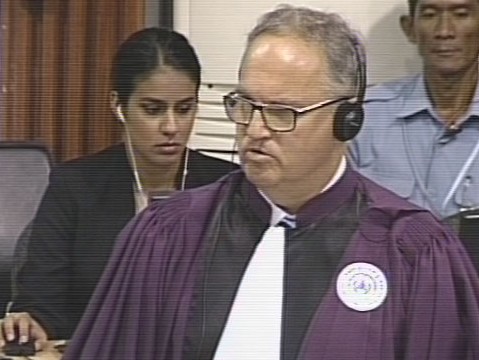
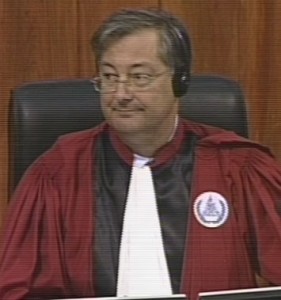
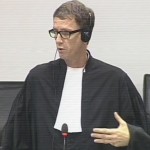
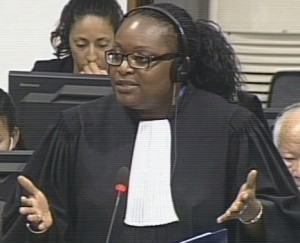
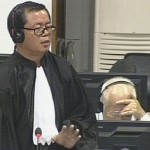
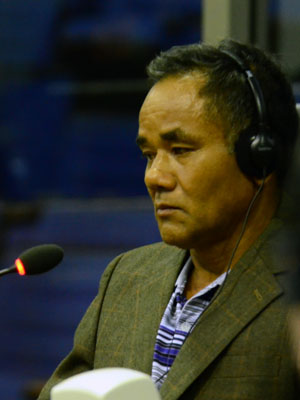
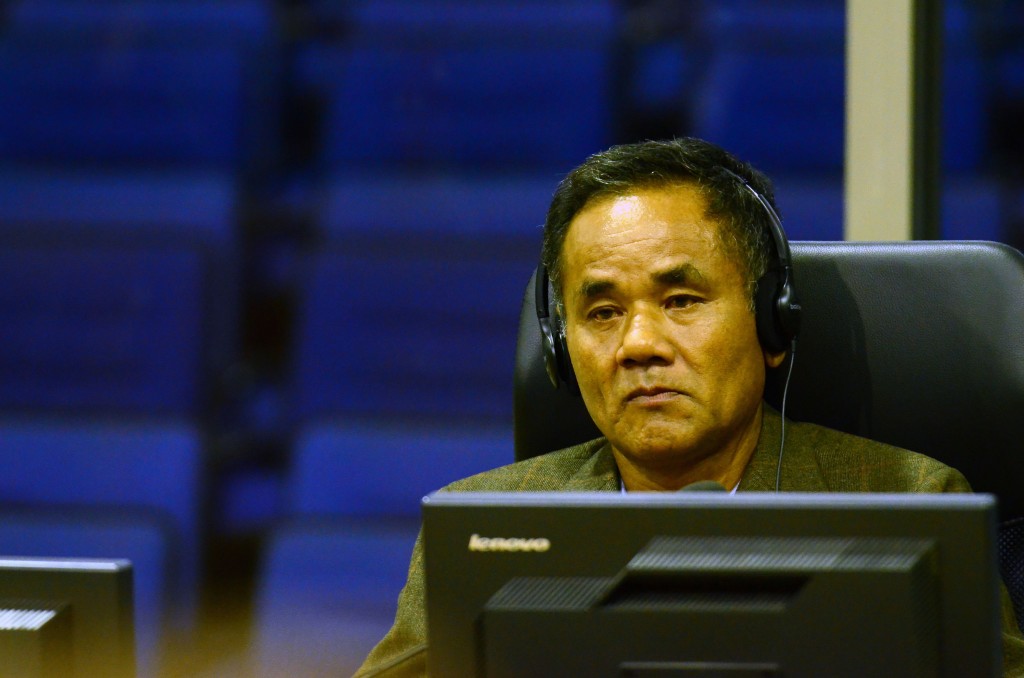
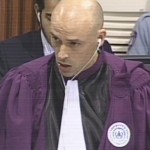
[…] Today, on August 11, 2015, the Trial Chamber continued to hear witness Mr. Kan Thol (or Thorl). You can read yesterday’s examination of Mr. Thorl by the prosecution and the civil party lawyers here. […]
[…] and distributed to all parties. He says he is making an oral 87(4) request to admit new evidence. (This post from August 10 has the full text of Internal Rule of Evidence 87(4) as a footnote.) After lunch, […]